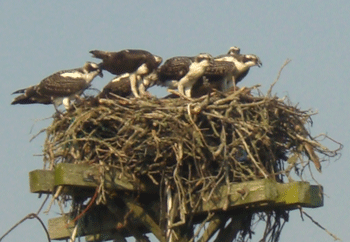




CONTENTS of the Osprey Pages
|
Intro-Overview of my Osprey research History of Martha's Vineyard Ospreys Satellite Tracking of Migration The Technology of Tracking Link to 2008 Migration Link to 2009 Migration Link to 2010 Migration Link to 2011 Migration Link to 2012 Migration Link to 2013 Migration Other Osprey Links: David Gessner's OspreyWorld Blackwater National Wildlife Refuge Lots of great links here, nestcams included Woods Hole, MA, Osprey cam |
 Mom, Dad and four fledglings crowd into the Lobsterville nest, the most productive Osprey nest on Martha's Vineyard over the past 11 years. (Photo by Cheryl Batzer.) |
In 1969, when I began studying the birds of prey on Martha's
Vineyard, there were two pairs of Ospreys on the Island. By 1992, thanks to the efforts of
Gus Ben David, then director of Mass Audubon's Felix Neck Wildlife Sanctuary,
and a large
number of Osprey devotees working under his guidance, the population had increased to over 70 pairs. In the early to mid-90s, the
Ospreys suffered a significant decline in their nesting success, but have since
shown strong signs of recovery. Gus monitored the population
through the '94 season. I picked up the census again in 1998 and,
with the help of some graduate students and a number of Island residents, have
monitored the number of breeding pairs and the number of young fledged each
year. (Details)
In 2000 I began collaborating with Mark Martell on his
studies of Osprey migration. A small (and rather expensive) transmitter attached
to an Osprey's back enables us to track a bird daily as it migrates.
We tagged
two Ospreys in 2000-2001, and since then have
deployed transmitters on 31
more, mostly on Martha's
Vineyard. Beginning in 2004, we have been concentrating on following young birds
on their first migrations. This year (2009) will mark the end
of our studies of juvenile Osprey migration and the beginning of a study of
adult males' hunting behavior. (Details)
In 2004 one of my graduate
students, Jennifer Rettew, began studying the Vineyard Ospreys for her M.Sc.
thesis. She is watching a series of nests to quantify and identify the fish that
are being brought in by the parents. She will be looking for differences in diet
and reproductive success between pairs from different parts of the Island.
Working with the BBC on their
upcoming documentary series, "Incredible Journeys," we tagged
five new birds--two adults and three young of the year. (Details)
In 2005 Jennifer spent her second and final
season watching 16 Osprey nests, focusing on the relationship between feeding
rates, sibling aggression, and nesting success. She successfully defended her
M.Sc. thesis in the spring of 2006.
Spurred on by our success with tagging young birds in
'04, I decided to focus all my attention on satellite tagging young birds. That
year we tagged two young--one on the Vineyard and one in Rhode Island.
In 2006 we tagged three birds in Delaware in or
around Cape Henlopen State Park, one in Rhode Island, and a single bird on the
Vineyard. One or the young birds tagged for the BBC, Jaws, returned to the
Vineyard for the first time.
In 2007 we tagged five birds again--two in
Delaware and three on Martha's Vineyard. Jaws, from the class of '04 returned
for his second trip home, and Homer, tagged near Little Homers Pond on the
Vineyard, returned for the first time. This was the first
year we used GPS enabled transmitters, which opened up a whole new world of
research possibilities. The previous transmitters were accurate enough to follow
migration, but not to follow the daily hunting movements of individual Ospreys.
In 2008 we tagged seven young
Ospreys--one in South Carolina, one in Delaware, two on Cape Cod, and three on
Martha's Vineyard.
In 2009 we have initiated our studies of adult hunting behavior by tagging 4 adult males--3 on the Westport River, just west of New Bedford, MA, and one on Nantucket Island. If all goes well, we will outfit 8 young with transmitters in July and August.
![]()
Top - Home - Habitat Fragmentation - Neotropical Birds - Birds of Prey - Graduate Students - Conservation Organizations - Publications - Ornithology